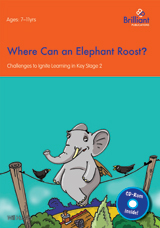A quick, creative challenge at the start of each day helps Will Hussey's pupils work up an appetite for learning...
Most people arrive at a restaurant feeling hungry, anticipating the delights the menu has to offer. If the cuisine is, indeed, fine – it will soon be eagerly devoured.
The same cannot always be said for the classroom; pupils do not automatically arrive salivating over the curriculum. They walk through the door at a particular time and are required to engage in ‘schooling,’ a process that hopes teaching will translate to learning.Alas, even with the teacher’s best efforts, that doesn’t always happen. If a pupil’s just not in the mood, they’ll simply pick over what’s on offer for the day.
Facing this predicament in my own classroom, the old adage about ‘taking horses to water,’ sprang to mind. What was it, I wondered, that makes the horses drink – or think?
 Creating an appetite for learning seemed to be the key. If I could somehow instil a collective desire to embrace the challenges of the day, then lessons would surely be more productive. Given that every pupil steps through the school gates invarying frames of mind, I needed a way of calibrating the class; bringing them to a point from which they could all successfully embark on the day’s activities. I subsequently devised a programme of challenges for igniting learning.
Creating an appetite for learning seemed to be the key. If I could somehow instil a collective desire to embrace the challenges of the day, then lessons would surely be more productive. Given that every pupil steps through the school gates invarying frames of mind, I needed a way of calibrating the class; bringing them to a point from which they could all successfully embark on the day’s activities. I subsequently devised a programme of challenges for igniting learning.
Each challenge is designed to have no wrong answer. By eliminating the possibility of failure, I found every child would feel comfortable in engaging with the task. The instructions for each challenge would be clearly displayed prior to the pupils’ arrival, enabling children to initiate their responses without prompting by myself.
The nature of the challenges varies; encouraging thinking, drawing, sharing, philosophising and questioning (amongst other things). The children have not just become more receptive to the notion of schooling, but more pro-active and involved in their learning.
Chicken and egg activities promote the philosopher within: not just finding the answers, but posing the questions.
Navy Who
Imagine you lived in a world where the colour blue did not exist. What shades could the skies and oceans be instead? Can you think of any other examples of blue items, and what colours/ patterns would they be replaced with?
For Example
The sky could be replaced with a shade of purple, my favourite football team would have to have claret-and-green stripes, the Red Sea would really be red.
Quick draw activities facilitate thinking in pictures, opening channels of inspiration and expression. They transform words from the tip of the tongue to the tip of the pencil.
Life drawing
Imagine the story of your life has been made into a hit film. Draw the front cover of the DVD.
For Example
The Eliminator, starring L E Phant… The different genres that the children choose to illustrate their covers can be quite interesting.Many pupils will also include the names of those starring in the film and other production details.
These challenges provide a popular topic of conversation, encouraging children to meet and greet their peers in preparation for further collaborative working.
Knot to everyone’s taste
Take a length of string and tie a knot in it. Ask everyone in the class to add another knot. Keep this in your pocket or tray as a ‘good luck’ charm.
For Example
Locating the position of a knot on the string, and keeping it distinct from amalgamating with others, requires careful handling.
 In his book, Where can an elephant roost?, Will Hussy has gathered and devised 180 terrific warm up exercises for the mind, a small sample of which feature in this article. The challenges are clear and self-explanatory, take no more than 15 minutes to run and will get pupils in the mood for learning. For more information visit brilliantpublications.co.uk
In his book, Where can an elephant roost?, Will Hussy has gathered and devised 180 terrific warm up exercises for the mind, a small sample of which feature in this article. The challenges are clear and self-explanatory, take no more than 15 minutes to run and will get pupils in the mood for learning. For more information visit brilliantpublications.co.uk
Top tips for differentiation
Ace-Maths
How to be a singing school
Ace-Music
Pie Corbett’s bike poems
Topic
Use scaffolding to wean children off high levels of TA support
Ace-Kitchen-Manager
